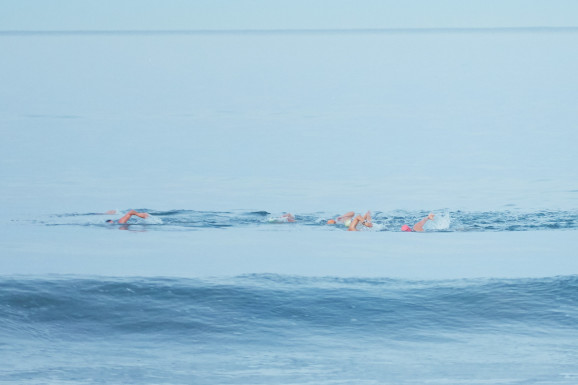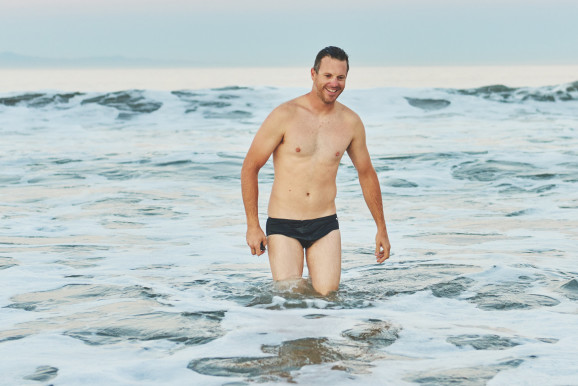Swimmers Are First to Conquer Channel Off California Coast

SAN PEDRO, Calif. — The boat stopped 300 yards off San Nicolas Island at 5:30 a.m. Monday, and Zach Jirkovsky was among those who stirred from his bunk. An environmental engineer, he had been to the island two years before for work, and ever since, he had been thinking about a return trip and about swimming the 70-mile channel back to the Southern California mainland.
It was far too great a distance to bridge alone, so he asked his friends from a swim group called the Deep Enders in Ventura, Calif., to take on the challenge as a relay. Most of the Deep Enders were collegiate swimmers once upon a time, and all had serious channel crossings on their résumés.
They did not need much persuading.
Jirkovsky, 34, and Tamie Stewart, 42, stood on the deck of the boat, the 63-foot Bottom Scratcher, and marveled at the island before jumping into the water and, escorted by a kayaker, making the easy 10-minute swim toward dry land. One must receive permission to visit the island because it is a United States Navy base, and Jirkovsky had approval.

Stewart stayed in water waist deep as Jirkovsky emerged from the sea at Cissy Cove, greeted by three sailors, all armed. Channel swimmers must begin “toes dry,” and Jirkovsky took several steps beyond the tide line to make sure the swim would qualify. Then he placed his goggles over his eyes, jogged back toward the sea and began to swim.
The sailors honked horns and flashed blue and red lights in salute. The captain of the Bottom Scratcher sounded her horn, too, and the Deep Enders and their support team cheered. If all went according to plan, within 36 hours, they would make open-water swimming history.
Jirkovsky and Stewart swam back toward the boat, and only Stewart got out. She would be the last of the six-person relay team to swim a shift. Each would swim for an hour before yielding to the next, and for the crossing to qualify officially, the team would have to maintain that order, and each athlete would have to spend an hour in the water when the time came. If one of them quit for any reason, the attempt would fail.
Jirkovsky kept swimming, following the kayak, which followed the support boat. The current was at his back. After an hour, the team’s leader and coach, Jim McConica, 64, jumped in — the first shift change. By the time John Chung, 45, tapped him out, the Deep Enders were off to a splendid start.
By 3 p.m. Monday, though, the team was fighting the current and dealing with a seven-foot swell. The battle peaked 20 miles into the swim as the team approached Santa Barbara Island that night.
“The island is shaped like an airplane wing,” McConica said, “and the volume of water sweeping around that island was hugely powerful and cut our speed.”
Until then, the swimmers had been averaging 5,200 yards an hour. In the face of that current, McConica still managed 2,600 yards during his hour, but others could barely swim 900 yards.
“We were almost at a dead stop,” McConica said. “It was a difficult moment, and the moment lasted about four hours.”
It did not help that it was pitch-black.
“All of us have swum in the middle of the night before, but it had never been quite this dark,” said Stacey Warmuth, 59, who drew the team even with Santa Barbara Island and around its southern point.
Stewart said: “There was no moon, and the water was moving in every direction. I felt like I was in a washing machine.”
With the worst of the swirling current behind them, the swimmers still fought the current, wind chop and swells until well after sunrise.
In the midst of a record heat wave, the air was warm through the night, and the water temperature was over 70 degrees almost the entire way, so hypothermia was not an issue. But jellyfish were. Open-water swimmers are not permitted to wear wet suits or rash guards on crossings, and all of the Deep Enders were stung repeatedly. Stewart soon had welts up and down both forearms.
There were also two shark sightings. Late Monday afternoon, the team saw a five-foot shark trailing Chung, although it kept its distance. On Tuesday morning, after the team cleared Catalina, a six-foot shark passed in front of the escort kayak while McConica was swimming. The boat captain asked McConica to swim closer to the boat and warned his teammates that if the shark drew any nearer, he would have to pull McConica from the water and end their quest.
But the shark disappeared, the current turned at midmorning Tuesday, and for the final five hours of the swim, the athletes swam with the current, their every stroke infused with the momentum of the ocean. Warmuth took the final shift as the Deep Enders closed in on the Palos Verdes Peninsula.
“I was just gliding across the water,” Warmuth said. “It was very fluid; the water was warm and glassy. It was an amazing feeling.”
With the Palos Verdes bluffs looming larger with every stroke, the sea became murky as four-foot waves swelled and thrashed the rocky shore. Behind Warmuth, her teammates dived into the water and swam to shore in a V formation, symbolizing victory. Warmuth checked the waves, timed it right and let the tide push her onto the rocks, crusted with razor-sharp barnacles.
At 4:52 p.m. Tuesday — 33 hours 37 minutes 26 seconds after the relay began — Warmuth took the required three steps clear of the tide line, not far from the Terranea Resort, in Rancho Palos Verdes. Soon her friends joined her on shore. Having navigated swirling seas, thick with jellyfish and as deep as 1,000 feet in some places, they hugged and celebrated, elated and exhausted.
“There were so many moments of cooperation and mutual support, when people were fatigued and sleep-deprived and then still got up to go swim in the ocean at maximum effort,” Tom Ball, 55, a longtime Deep Ender, said. “This is a team of people from the same community who went out and achieved something that’s never been done, and I think that’s very special.”
